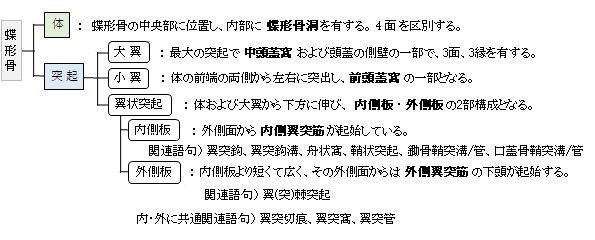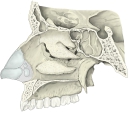

・「翼状突起の内側板は細長く殆ど矢状位に立ち…」(船戸和也のHP)

【その他の特徴】
以下に内側板の特徴を簡単にまとめてみた。(参考:船戸和也のHP)
・内側板と外側板の後方は翼突窩という深さのある窩を形成し、内側翼突筋の起始部となる。
・内側板の下端は鈎状に外側方に曲がり翼突鈎となる。
・「その(翼突鈎)上にある浅い翼突鈎溝は口蓋帆張筋の腱が通るところである。」(船戸和也のHP)
・内側板の後縁は上部で2つに分かれて浅い陥凹である舟状窩(口蓋帆張筋の起始部)を囲っている。
・舟状窩の上に接して耳管溝(耳管軟骨部の付着部)が斜め上外方に走り大翼の後縁まで続いている。
・内側板の上端から内側方に向かって薄板状の鞘状突起が蝶形骨の下面に沿うように出る。
・鞘状突起の下面にある細い溝(口蓋骨鞘突溝)は後方から前方に行くに従って深さをまし、口蓋骨の
蝶形骨突起と合して口蓋骨鞘突管を形成する。
・鞘状突起の内側縁と蝶形骨体の間にできる鋤骨鞘突溝は鋤骨の鋤骨翼が蝶形骨と合すると鋤骨鞘突管
となる。溝、管のいずれにしても蝶口蓋動脈の枝および翼口蓋神経節の咽頭枝が通るところとなる。
|
|
|
|

|
蝶形骨(前面) |
蝶形骨(前面) |
外頭蓋底 |
外頭蓋底 |
右鼻腔(外側壁) |
 |
|
|
|
|
蝶形骨(底面) |
|
|
|
|
以下は「Wikipedia」の解説文となる。
The medial pterygoid plate (or medial pterygoid lamina) of the sphenoid bone is a horse-shoe shaped process that arises from its underside.
It is narrower and longer than the lateral pterygoid plate and curves lateralward at its lower extremity into a hook-like process, the pterygoid hamulus, around which the tendon of the tensor veli palatini glides.
The lateral surface of this plate forms part of the pterygoid fossa, the medial surface constitutes the lateral boundary of the choana or posterior aperture of the corresponding nasal cavity.
Superiorly the medial plate is prolonged on to the under surface of the body as a thin lamina, named the vaginal process, which articulates in front with the sphenoidal process of the palatine and behind this with the ala (wing) of the vomer.
The angular prominence between the posterior margin of the vaginal process and the medial border of the scaphoid fossa is named the pterygoid tubercle, and immediately above this is the posterior opening of the pterygoid canal.
【 語 句 】
・sphenoid bone:蝶形骨 ・lateral pterygoid plate:外側板 ・pterygoid hamulus:翼突鈎 ・tensor veli palatini:口蓋帆張筋 ・pterygoid fossa:翼突窩 ・constitute:構成する ・choana:孔鼻孔 ・nasal cavity:鼻腔 ・vaginal process:鞘状突起 ・sphenoidal process:蝶形骨突起 ・ala of the vomer:鋤骨翼 ・scaphoid fossa:舟状窩 ・pterygoid tubercle:翼状結節 ・pterygoid canal:翼突管
On the under surface of the vaginal process is a furrow, which is converted into a canal by the sphenoidal process of the palatine bone, for the transmission of the pharyngeal branch of the internal maxillary artery and the pharyngeal nerve from the sphenopalatine ganglion.
The pharyngeal aponeurosis is attached to the entire length of the posterior edge of the medial plate, and the constrictor pharyngis superior takes origin from its lower third.
Projecting backward from near the middle of the posterior edge of this plate is an angular process, the processus tubarius, which supports the pharyngeal end of the Eustachian tube.
The anterior margin of the plate articulates with the posterior border of the vertical part of the palatine bone.
In many animals it is a separate bone called the pterygoid bone.
【 語 句 】
・furrow:溝 ・palatine bone:口蓋骨 ・pharyngeal branch of the internal maxillary artery:内頚動脈の咽頭枝 ・pharyngeal nerve :咽頭神経 ・sphenopalatine ganglion:翼口蓋神経節 ・pharyngeal aponeurosis:咽頭腱膜 ・constrictor pharyngis superior:上咽頭収縮筋 ・processus tubarius: ・Eustachian tube:耳管 ・articulate with~:~と接合する ・vertical part of the palatine bone:口蓋骨の垂直板 ・pterygoid bone:翼状骨
■ 写真やイラストを掲載しているサイト ■
・ イラストや写真を掲載しているサイト-Ⅰ
・ イラストや写真を掲載しているサイト-Ⅱ
・ イラストや写真を掲載しているサイト-Ⅲ
・ イラストや写真を掲載しているサイト-Ⅳ
